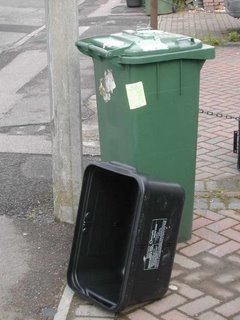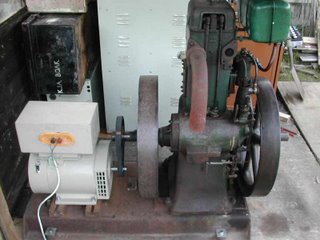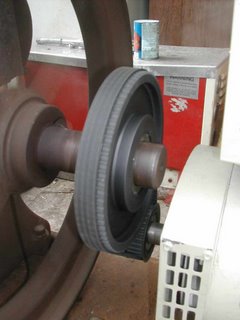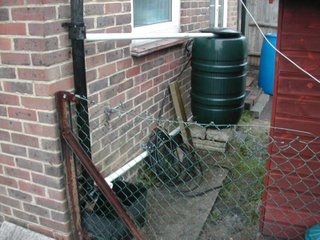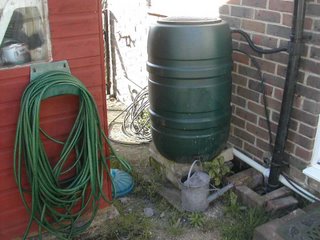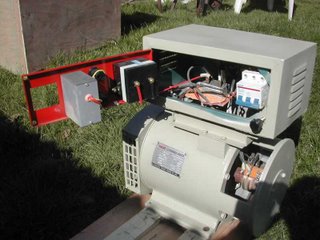
This is a popular misconception, created by the media. Being green is very easy, it's all about reducing consumption and minimising waste.
Increasingly it's about taking a standpoint against the global corporations that are trashing our planet, our country and our neighboourhood. Watch out Sainsbury's, McDonalds and BP, we will soon be parting company.
It's also the title of a new TV series (almost) - Tuesday BBC2, featuring Cmdr. Dick Strawbridge and his family. Having sold up in Worcestershire and moved down to a rambling farmhouse in Cornwall, they set about a new green lifestyle.
Whilst the programme is good entertainment value, with a few important messages and a likeable, lively presenter, it did have a fair budget behind it, and not everyone can rustle up £535,000 for a listed Cornish farmhouse property and then have £50K available to re-roof it. Nor does everyone have access to a small army of student volunteers as a workforce. *
Suitably inspired by programme 1, and with the pleasure of the first Daffodills emerging around the apple tree, I thought I would give some thought to what could be done with a more average property in Suburbia - mine in fact.
First a quick survey of what resources are available:
1 A good sized back garden, 65m long by 6m wide, with good black fertile soil.
2. A collection of sheds, with a few machine tools, equipment and garden implements.
3. DIY Plumbing and guttering - easily modified to capture and store rainwater and greywater.
4. A 100 square metre semi-detached house facing south west with 65 m2 of roof area
4. Not only a fertile garden but a fertile imagination and the drive to make things happen.
5. An engineering background, good tinkering skills and a few good mates.
Time to come up with a plan, it's early April now, and I need to get cracking.
1. Get rid of all unnecessary rubbish, better allocation of storage space
2. Install rainwater catchment system
3. Install greywater storage system
4. Prepare vegetable plots - get planting
5. Permanent site for solar heating panel
6. Veg-oil engine and alternator installation
7. Battery bank, inverter and back up power system
The bulk of my fossil fuel energy use is over for another six months, the days are getting longer and it is time to tap into the natural resources to get the best out of them. Perhaps its easy to overlook the natural resources when you are living in the middle of an urban environment.
Not being blessed with the multitude of stone built outhouses of Dick Strawbridge and family, I have to make better use of the 3 sheds and greenhouse. These have become dumping grounds for unwanted household possessions, to its time to have a clearout and regain some square footage. The advantage of the sheds is that they can be south facing, to make the best use of solar gain, and useful roof space to put the solar water heating and small pV array.
Reducing fossil fuel use for next winter and water consumption are high up on the list of priorities, and also making better use of the 390 square metres of back garden space, for growing a few vegetables, and housing various renewable energy products.
The rubbish heap at the bottom of the garden has been mostly cleared, the biomass rubbish burned and the ashes scattered to improve the quality of the top soil. This area has had the compost heaps located there for the last 5 years so has good rich soil. It also receieves the most hours of sunshine as it is not overshadowed by the hour. This will shortly be rotorvated to provide 60 m2 of new vegetable beds.
The small greenhouse, also towards the north end of the garden is needing a few panes replaced but very soon will be ready for planting tomatoes, peppers and other useful crops.
Other projects include a rainwater capture system. I have aquired some 208 litre plastic barrels, and these will make ideal storage butts for rainwater and grey water. Renewing some of the roof guttering will allow all of the run off from the roof to be diverted to a water catchment and filtration tank. The rainwater can be used for toilet flushing and garden watering, and I have a convenient spare room on the first floor, about to be converted into a 2nd bathroom, where the rainwater capture tank can be located. As this room has an open fireplace with a 208mm square steel beam supporting the chimney breast, I can afford another 250kg of rainwater tank over this beam.
With more hosepipe bans being announced this morning by local water companies, in the south east, saving water is going to be a priority this year.
Grey water from the kitchen and bathroom can also be collected, and whilst these rooms are on the ground floor, there is a 1m fall down the length of the garden, which will allow the grey water to fill a tank next to the vegetable plot and lawn and be used for watering purposes.
Domestic energy consumption and bills have been driven down this last 6 months. We are now almost out of the heating season, down from 90kWh per day to about 40kWh. A new method of keeping the living space at 17 C during the day, and turning up to 19 C for a few hours in the evening has made a major reduction to the gas consumption. October to March inclusive is down from 16597kWh last year to this 14488 kWh this heating season. This 13% saving of gas, 2109kWh, is worth about £60 off the gas bill.
Equally, electricity usage for the same period is down from 2020kWh last year to 1492 units this year, a 26% saving amounting to £42 off the electricity bill.
So, a £100 saving on the utility bills in just 6 months. The e-plan diet certainly seems to be working!
By the middle of March, the solar water heating panel was beginning to make a significant contribution to the domestic hot water, as the hours of sunshine per day, incident on the panel slowly increased. It is now time to get a more permanent and reliable installation.
Not only that, but the garden seems to be flourishing from the extra sunshine and the first of the long awaited rain showers.
* Any students in the North East Surrey/Redhill area? - I may have something of interest for your Easter break. ken.boak@gmail.com


